|
[ Section Amanita page. ]
[ Amanita Studies home. ]
[ Keys & Checklist/Picturebooks ] "Euro-Asian Fly Agaric"
Technical description (t.b.d.) BRIEF DESCRIPTION: Amanita muscaria is the common, bright red fly agaric of northern Europe and Asia. Due to slow development of the purple pigment in the cap skin, the cap may be orange or yellow (or rarely, have red and yellow alternating sectors) at first. It is possible that some European populations may be have consistently yellow or white caps as happens in North America to this species in northwestern North America (Geml et al., 2008). Its cap is 90 - 145 mm wide. The volva is distributed over the cap as white or yellow warts that are easily removed by rain. The gills are free to narrowly adnate, crowded to subcrowded, and white or whitish both in mass and in side view. The short gills are truncate. The stipe is 60 - 210 x 8 - 22 mm and has a skirt-like annulus and notable bulb of rather variable shape (up to 46 x 45 mm). Rings of volval material commonly encircle the top of the bulb and the base of the stipe. The spores measure (7.4-) 8.5 - 11.5 (-13.1) x (5.6-) 6.5 - 8.5 (-9.8) Ám and are broadly ellipsoid (infrequently subglobose or elongate) and inamyloid. Clamps are very common at bases of basidia. Because yellow warts are not uncommon in the type variety, microscopic characters must be used to distinguish it from the North & Central American native, Amanita muscaria subsp. flavivolvata Singer. Distinguishing microscopic characters include difference in the thickness of the subhymenium and differences in size and shape of their spores. I will treat this in detail in the "technical details" page when the latter is ready for publication. Geml et al. (2008) have demonstrated that segregation at species rank is also supported on molecular grounds. The species is toxic and is well-known for its use by shamans of northern cultures. Amanita muscaria occurs throughout Europe and northern Asia
Other apparently closely related taxa include A. breckonii Thiers & Ammirati, A. gioiosa Curreli, A. heterochroma Curreli, the varieties of the present species, and A. regalis (Fr.) Michael. All of these species have easily found clamps at bases of their basidia. A number of them are also quite unusual in Amanita in that tissues from them will rapidly and robustly produce a vegetative culture. The species is associated primarily with Birch and diverse conifers, but has been found in mixed forest with other deciduous trees, in forests of pure Tilia (in Norway), with dwarf willow (Salix repens) on the Island of Terschelling (Prov. Friesland, the Netherlands, see photo at right), and adapted to living with eucalypts in Australia and Argentina, etc. -- R. E. Tulloss Photos: R. E. Tulloss (above text, Scotland)
[ Section Amanita page. ]
[ Amanita Studies home. ]
[ Keys & Checklist/Picturebooks ] Last changed 2 March 2009. |
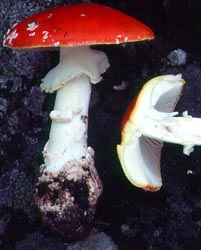
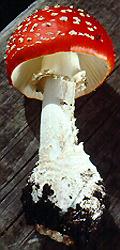
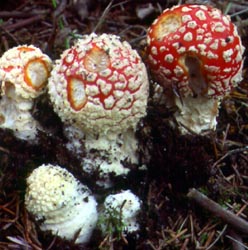
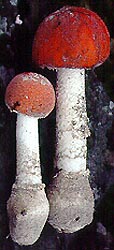
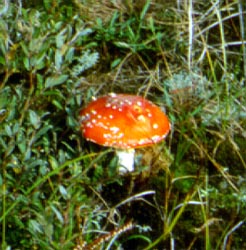 (famously in Siberia) and in western Alaska. It is one of the amanitas that is most easily (and frequently) introduced with imported trees --
e.g., in pine and eucalypt plantations. It appears to be able to take on many genera of plants as ectomycorrhizal symbionts.
(famously in Siberia) and in western Alaska. It is one of the amanitas that is most easily (and frequently) introduced with imported trees --
e.g., in pine and eucalypt plantations. It appears to be able to take on many genera of plants as ectomycorrhizal symbionts.